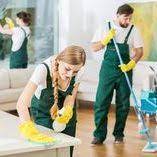If your office still feels grimy after a clean, you’re not imagining it. A poor office cleaning routine doesn’t just impact first impressions — it quietly chips away at staff health, morale, and even productivity. Here’s a quick snapshot of the warning signs:
- Frequent sick days and low energy across teams
- Unpleasant smells that linger, no matter what
- Dusty desks and cluttered communal areas
- Complaints about cleanliness from visitors or clients
- Cleaning that looks rushed, patchy, or half-done
If any of these ring true? It might be time to rethink your cleaning strategy.
How do you know if your office cleaning isn’t good enough?
Anyone who’s worked in an office knows — you feel a dirty space before you see it. Even subtle lapses in cleanliness affect how people move, think, and collaborate. Here’s how to spot when your current approach just isn’t cutting it.
1. Staff illness rates are quietly climbing
You might think a few sniffles are harmless. In some cases, sure — it’s just winter. But if you’re noticing more sick days than usual, it’s worth asking: is the office environment contributing?
Poor office cleaning means germs stick around on shared surfaces like desks, kitchen counters, and door handles. Viruses and bacteria don’t need much encouragement. Regular, high-touch surface sanitisation is non-negotiable. Without it, even a small oversight can ripple into widespread absenteeism.
Quick tip: Keep an eye on sick leave trends over months, not just weeks. Long-term patterns tell a clearer story.
2. There’s a smell you just can’t shift
Here’s the thing about smells — by the time you notice them, clients and visitors definitely have. Funky odours in office kitchens, bathrooms, or even open-plan areas usually hint at underlying hygiene issues.
And no, blasting air fresheners isn’t a fix. It masks the problem. Dirty bins, clogged drains, old carpet spills — these all need real, hands-on cleaning.
Anyone who’s hosted an important meeting knows: nothing distracts faster than a whiff of yesterday’s lunch hanging in the air.
3. Dust and clutter are building up
You walk into a meeting room. The table’s dusty. Chairs have random crumbs. There’s a crusty coffee ring on the counter. It might seem small. But these little signs add up to one big message: this place isn’t cared for.
Worse still? Dust triggers allergies and breathing problems. Especially in air-conditioned spaces where particles keep circulating.
Pro tip: run your hand lightly across a desk surface at random. If you pick up visible dust, your cleaning schedule isn’t frequent enough — or not detailed enough.
4. Staff and visitors are quietly complaining
Most people won’t march up to management to complain about a messy toilet or a grubby break room. They’ll just… quietly avoid them. Or worse, start joking about it (you don’t want to be “that office”).
Listen carefully. Offhand comments like “it’s a bit gross in there” or “someone needs to do something” are low-key SOS signals. People notice. They care. And if it affects morale, it inevitably affects performance.
Makes sense, right? If your team doesn’t feel good about their space, how can you expect them to do their best work?
5. Cleaning looks rushed or inconsistent
Ever spotted a bin overflowing right next to a freshly vacuumed floor? Or a shiny lobby but a filthy lift button? That’s a dead giveaway your office cleaning routine isn’t systematic.
Professional office cleaning should follow a set checklist. High-touch surfaces? Daily. Bins? Emptied. Bathrooms? Disinfected. Not all tasks need daily attention, but important zones certainly do.
Real talk: Cleaning isn’t about doing everything all the time. It’s about doing the right things, consistently, with pride.
What should a good office cleaning routine look like?
- Daily basics: Empty bins, wipe desks, sanitise high-touch points, clean bathrooms.
- Weekly tasks: Mop floors, clean windows, deep clean kitchen areas.
- Monthly/Quarterly: Shampoo carpets, clean air vents, steam furniture.
Consistency, visibility, and quality checks are the hallmarks of a well-run cleaning program. Anything less? You’re setting yourself up for issues later.
FAQs: Office Cleaning Red Flags
Q: How often should an office be professionally cleaned?
A: Most offices need professional cleaning at least daily for high-traffic areas, with deeper periodic cleans monthly or quarterly depending on size and use.
Q: Is it normal for offices to smell between cleans?
A: Not really. Persistent odours usually mean something’s being missed, like bin management, food waste, or inadequate bathroom cleaning.
Q: Should staff be responsible for their own desk cleaning?
A: Light tidying, sure. But sanitisation, dusting, and proper waste management should fall to professional cleaners, not busy employees.
Final thoughts: Does your office feel clean?
At the end of the day, office cleaning isn’t just about ticking a chore list. It’s about creating an environment where people want to show up, collaborate, and bring their best. If your office isn’t achieving that, it’s worth reviewing your current setup — and finding a service that genuinely lifts the standard.
Speaking of standards, if you’re reviewing your cleaning needs, it’s smart to explore options for a commercial cleaning company that matches your team’s expectations.
For further reading on best practices, check out this guide to workplace hygiene improvements by Safe Work Australia.

